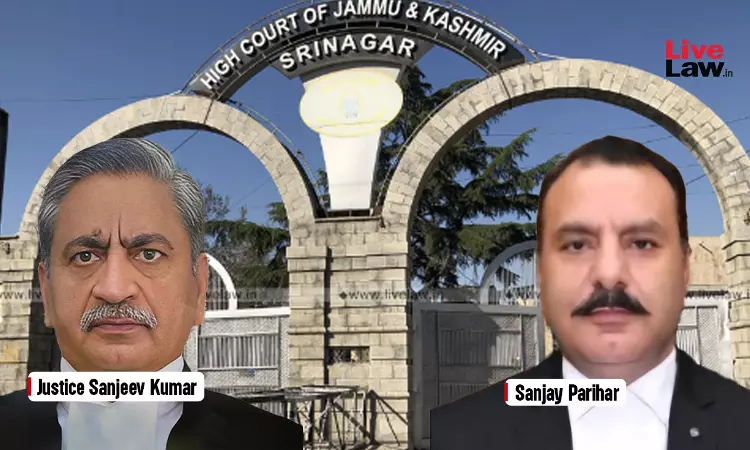- Home
- /
- High Courts
- /
- High Court of J & K and Ladakh
- /
- 'Ziyarat' That Qualifies As “Wakaf...
'Ziyarat' That Qualifies As “Wakaf By User” Needs No Formal Declaration To Be Treated As Wakaf: J&K High Court
LIVELAW NEWS NETWORK
16 Jun 2025 11:45 AM IST
The High Court of Jammu and Kashmir and Ladakh has held that a Ziyarat (shrine), Dargah, or other religious property that qualifies as a "Wakaf by user" under Section 3(d)(i) of the Jammu & Kashmir Wakafs Act, 1978, does not require a formal declaration or notification to be treated as Wakaf.The Division Bench comprising Justice Sanjeev Kumar and Justice Sanjay Parihar thus dismissed...
The High Court of Jammu and Kashmir and Ladakh has held that a Ziyarat (shrine), Dargah, or other religious property that qualifies as a "Wakaf by user" under Section 3(d)(i) of the Jammu & Kashmir Wakafs Act, 1978, does not require a formal declaration or notification to be treated as Wakaf.
The Division Bench comprising Justice Sanjeev Kumar and Justice Sanjay Parihar thus dismissed an intra-court appeal challenging the takeover of a shrine by the J&K Wakaf Board, asserting that user-based Wakafs stand protected under law, regardless of any formal gazette declaration.
The case arose from an appeal filed by the Intizamiya Committee Dargah and its Manager, Haji Abdul Ahad Akhoon, against the judgment of the learned Single Judge. The appellants had filed a writ petition under Article 226 of the Constitution challenging Orders and a communication issued by the J&K Wakaf Board. These administrative actions led to the takeover of management of the shrine known as “Ziyarat Sharif Syed Khazir Sahib” located in District Ganderbal.
Akhoon claimed ownership and possession of 5 kanals of land recorded under Khasra No. 323 at Rayil Gund. He asserted that he had personally developed the shrines of Syed Jaffer, Syed Rehman, and Syed ul-Hajra over this land, which had been previously neglected. He formed an Intizamiya Committee to manage these shrines and claimed that his efforts were appreciated by the local community. However, in 2015, disputes arose when third parties approached the Revenue Department to request takeover of the shrine's management.
In response, the appellants filed a writ that was ultimately dismissed as infructuous after the respondents stated that the statutory provisions (Wakafs Act, 2001 and J&K Muslim Specified Wakafs Properties Act, 2004) had been repealed, rendering the 2015 communication moot.
However, shortly thereafter, the Wakaf Board issued a fresh order under Sections 67, 68, and 69 of the Wakafs Act, 1985, resuming control of the Ziyarat Sharif Syed Khazir Sahib. The appellants challenged this action in another writ which was dismissed by the writ court, prompting the present appeal.
The appellants contested the legality of the Board's action primarily on the ground that the land was privately owned and not notified as Wakaf. Secondly they argued that there was no publication of notification in the Government Gazette as mandated by Section 6 of the J&K Wakafs Act, 1978 and without such notification, the Wakaf Board had no authority to assume control.
Justice Sanjeev Kumar, writing for the Division Bench, carefully examined these claims and upheld the decision of the writ court. The judgment emphasized that the concept of Wakaf by user, as defined under Section 3(d)(i) of the 1978 Act, includes places like Ziyarats, Dargahs, Masjids, and other religious institutions that are “used as such” by the community. The Court noted that a Wakaf need not be declared formally or published in the gazette to attain the status of Wakaf when its usage clearly falls within the definition.
The Court referred to the definition clause in Section 3(d), which reads,
“Wakaf means the permanent dedication by a person professing Islam of any property movable or immovable for any purpose recognized by Muslim Law or usage as religious, pious or charitable and includes Wakaf by user such as Masjid, Idgah, Dargah, Khankah, Maqbara, Graveyard, Grave, Rauza, Mausoleum, Takia, Sarai, Yatim Khana, Madrasa and Shafakhana…”
Justice Kumar observed that the Ziyarat in question qualifies as a Wakaf by virtue of its usage, and therefore no formal declaration is necessary under the 1978 Act. He further clarified that Section 4 of the Act speaks of conducting a preliminary survey of Wakafs by Special Officers appointed by the Government. Such surveys presuppose the existence of Wakafs and are not aimed at creating Wakafs. Disputes arising during the survey are to be resolved based on deeds, if any, he emphasised.
The Court also held that the Ziyarats and Dargahs, being Wakafs by user, do not require a notification under Section 6. The function of Section 6 is merely to publish an existing list of Wakafs in the Government Gazette, the court said and added that It does not operate to create or declare a property as Wakaf. Thus, the absence of publication in the Gazette does not negate the legal status of the shrine as Wakaf, the bench underscored.
Importantly, the Court observed that the Wakaf Board had notified the shrine “Ziyarat Sharif Syed Khazir Sahib” under SRO 510 falling in a different khasra and the appellants' claim was over land, which was not part of the notified Wakaf.
“Since the property claimably owned and possessed by the appellants, which falls in Khasra No. 323 of Village Rayil, is not notified as Wakafs, as such, the appellants have no legal authority to challenge either the publication/ notification of the Ziarat as “Wakaf”, the court remarked.
In conclusion, the Court upheld the actions of the Wakaf Board and provided liberty to appellant to pursue legal remedies to protect any proprietary land rights stating that nothing in the judgment should impede his ability to approach appropriate forums.
Case Title: Intizamia Committee Vs UT Of J&K
Citation: 2025 LiveLaw (JKL) 238



